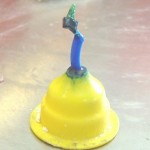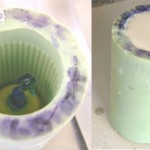The lost wax technique originally goes back to ancient times and is believed to have probably originated in China or Egypt. The method was employed to create figurines and objects in gold. Then in 1907, a centrifugal casting machine was invented by William H. Taggart. Although he patented his idea using the lost wax technique, he lost the patent when it was discovered another dentist had written a paper on the same idea some 25 years earlier.

Picture 1: Wax (blue-greenish colour) is formed into the desired tooth shape
In the art world, the process of a solid cast usually begins by sculpting in clay or another similar medium. A mold is then made, usually from rubber or silicone, and reinforced with something like fiberglass. It is inverted and filled with casting wax. The mold is removed and the artist “chases” surface imperfections with special tools to fix any flaws. In the dental industry, crowns are “waxed” (carved) to models made from dental impressions, and in the jewelry industry, custom designs are often carved from scratch out of wax to make the patterns.
Full gold crowns are cast metal restorations that are made using the lost-wax technique. After the dentist prepares a tooth for a crown, he or she will take an impression of the prepared tooth, the adjacent teeth in the same arch and the opposing teeth in the opposing arch.
With all of the necessary boundaries of the future cast crown defined in three dimensions within the impression material (i.e. the necessary height, width and depth of the crown is now recorded in impression material), the impression(s) are sent to a dental laboratory where they will be poured up in various types of dental stone or plaster.
After the stone models are formed, they are ditched, died and articulated so that the laboratory technician can see how the two arches meet and properly access the tooth replicates to perform his tasks.
The lab technician will then apply wax to the die (analog of the prepared tooth) and manipulate and craft the wax until he or she has built it up into what appears like and conforms to the specific dimensions of the tooth being restored (picture 1). Prior to applying the wax, though, a die spacer is applied to the die. This is a thin coat of material that is painted onto the die to provide a space between the gold crown and the actual tooth structure to be filled with cement upon final cementation. A lubricant is also applied so that the wax pattern, as the wax-up of the crown is referred to, can be easily removed when completed.
The wax pattern is removed from the die and invested in a sort of plaster while connected to a short plastic stick, called a “sprue former”, which will stick out of the investing plaster (picture 2). The sprue is an extension from the carved wax crown which goes downward toward the casting ring cap. The bulb in the hollow sprue functions as a gold reservoir and helps equalize pressure so the liquid gold flows evenly into the casting. Although metal in the sprues can be reclaimed and recycled, the goal is to minimize initial costs by using the least amount of metal possible when casting—especially if working with precious metals. The casting ring cap is positioned over the casting ring. The casting ring holds the plaster which flows around the casting.
Once the plaster has set, the casting ring cap is removed. This leaves the sprue protruding from the hardened plaster. The investment, as it is called now, is placed in a furnace, which will completely burn off the wax and plastic that formed the wax pattern/sprue complex. What is left is a hollow within the investment material, known as an “investment pattern”. Because the sprue former stuck out a little bit from the investment material, there is a communication between the outside and the investment pattern. The investment pattern is then placed in a sort of simple centrifuge where pennyweights of gold are melted down and rapidly shot through the communication in the investment pattern, through the sprue that was formed by the sprue former, and into the hollow that used to be inhabited by the wax pattern of the crown waxed-up by the technician, thus called the lost-wax technique.
The still-hot plaster is immersed in water, causing the plaster to shatter. After properly cooling, the single piece crown-and-sprue of gold is sectioned, and the sprue can be recycled in another casting. The crown is touched-up in the location of the sprue attachment, finished and polished to a high shine, and delivered to the dentist so that he or she can try it in the mouth, make certain it has all of the proper contacts with the adjacent and opposing teeth, and cement it to the prepared tooth.

